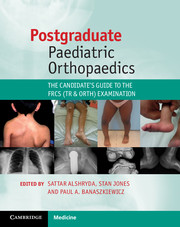Book contents
- Frontmatter
- Contents
- List of contributors
- Foreword
- Preface
- Acknowledgements
- Interactive website
- List of abbreviations
- Section 1 General guidance
- Chapter 1 Introduction and general preparation
- Chapter 2 History and examination of the paediatric patient
- Section 2 Core structured topics
- Section 3 Exam-related material
- Index
- References
Chapter 2 - History and examination of the paediatric patient
Published online by Cambridge University Press: 05 August 2014
- Frontmatter
- Contents
- List of contributors
- Foreword
- Preface
- Acknowledgements
- Interactive website
- List of abbreviations
- Section 1 General guidance
- Chapter 1 Introduction and general preparation
- Chapter 2 History and examination of the paediatric patient
- Section 2 Core structured topics
- Section 3 Exam-related material
- Index
- References
Summary
History and examination
The assessment of a child presenting with a musculoskeletal complaint requires a thorough history and full clinical examination and should be carried out in a child-friendly environment. If this is done properly, a diagnosis can be made in the majority of cases.
The initial contact with the child and family involves introducing oneself to all the family members, including the child. This should be carried out in a professional yet friendly manner. The cultural background of the family should be considered and it is important to conform to gender order for introductions.
The next stage of the assessment should aim to allay the anxiety or fear of the child. This can be done in a variety of ways and depends on the age of the child. In a younger child an introduction to toys may be all that is required, while in the older child this may involve talking about friends, sports, school or a piece of clothing.
- Type
- Chapter
- Information
- Postgraduate Paediatric OrthopaedicsThe Candidate's Guide to the FRCS (Tr and Orth) Examination, pp. 5 - 16Publisher: Cambridge University PressPrint publication year: 2014



